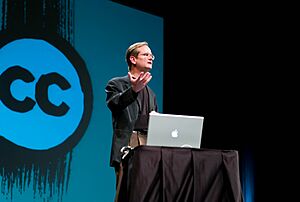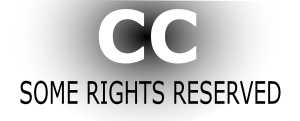Creative Commons facts for kids
| Founded | January 15, 2001 |
|---|---|
| Founder | Lawrence Lessig |
| Type | 501(c)(3) |
| Focus | Expansion of "reasonable", flexible copyright |
| Headquarters | Mountain View, California, U.S. |
| Method | Creative Commons license |
|
Key people
|
Anna Tumadóttir, CEO |
|
Revenue (2018)
|
|
Creative Commons (CC) is a non-profit group from the United States. It works to make creative works like photos, music, and writing easier for people to share and use legally. They offer free licenses that help creators decide how others can use their work.
These licenses let creators keep their copyright but also clearly show which rights they are sharing. This means you don't have to ask for special permission every time you want to use something. Instead, the Creative Commons license tells you exactly what you can do. Each license has easy-to-understand symbols and a simple explanation.
The organization was started in 2001 by Lawrence Lessig, Hal Abelson, and Eric Eldred. The first Creative Commons licenses were released in December 2002. Later, in 2002, the Open Content Project, an earlier sharing project, joined Creative Commons.
By 2019, nearly 2 billion works were using Creative Commons licenses. Big websites like Wikipedia use these licenses. In 2017, Flickr had over 415 million photos with CC licenses. Many other platforms also use them, including YouTube, DeviantArt, Wikimedia Commons, Stack Exchange, and Khan Academy.
Contents
What is Creative Commons For?



Creative Commons is part of a movement called "copyleft." This movement offers different ways to handle copyright, often described as "some rights reserved" instead of "all rights reserved." Creative Commons helps people share content more freely while still protecting their own creative rights.
According to founder Lawrence Lessig, Creative Commons aims to challenge the idea that only big companies can control creative works. He believed that traditional copyright rules made it hard for new artists to create and share. Creative Commons offers a way for creators to share their work more easily.
In 2020, Creative Commons announced its plan for the next five years. They will focus on promoting their ideas, improving their tools, and helping more people understand and use their licenses.
The Creative Commons Network
Until 2018, Creative Commons had over 100 groups in more than 75 countries. These groups helped spread the word about CC around the world. In 2018, this network changed. It now focuses on individual members organized into local "Chapters" instead of separate organizations.
Japan
Creative Commons Japan (CC Japan/CCJP) is the network for Creative Commons in Japan.
In 2003, a university in Japan started preparing for CC Japan. It officially launched in March 2004, becoming the second CC network in the world after the one in America.
In March 2006, CC Japan became a non-profit organization. The founder of Creative Commons, Lawrence Lessig, visited Japan for their opening ceremony. Many international events related to Creative Commons were held in Japan that year.
Over the years, CC Japan continued to grow. In 2009, they even worked with Apple on a project. In 2012, they celebrated their 10th anniversary. By 2015, the latest Creative Commons licenses were available in Japanese.
South Korea
Creative Commons Korea (CC Korea) is the network for Creative Commons in South Korea. It started in March 2005 as a project by a judge named Jongsoo Yoon.
Major Korean websites like Daum and Naver began using Creative Commons licenses. In 2009, CC Korea became a non-profit group. Since then, CC Korea has actively promoted open sharing and helped spread Creative Commons in the country.
Bassel Khartabil
Bassel Khartabil was a Syrian software developer who worked with Creative Commons Syria. He was a strong supporter of open sharing. In 2012, he was taken by the Syrian government. Creative Commons and many others called for his release. Sadly, his family learned in 2017 that he had passed away.
How Creative Commons Licenses Changed Over Time
All current Creative Commons licenses (except one for public domain) require you to give credit to the original creator. This is called "attribution." Sometimes, if a work uses many other works, giving credit to everyone can be tricky.
Some people worried that Creative Commons might weaken copyright rules over time. They thought it might make it too easy for people to use creative works without proper rewards for the creators.
However, Lawrence Lessig, the founder, explained that copyright laws have changed a lot over history. He said that copyright used to last for much shorter times. Creative Commons aims to find a middle ground between strict copyright and no copyright at all. It lets creators choose how much they want to share.
Early versions of Creative Commons licenses had some issues with certain software groups, like Debian. These groups have very strict rules about "free software." But Creative Commons updated its licenses (version 3.0 and later) to fix these issues. Now, most CC licenses are compatible with these strict free software rules, except for those that forbid commercial use or changes.
Some critics also felt that Creative Commons offered too many different licenses, which could make it confusing. They argued that it might lead to "license proliferation," where different licenses aren't compatible with each other. This means you might not be able to combine works with different CC licenses without getting special permission.
However, Creative Commons explains that its goal is to offer choices. It provides a range of licenses because creators have different needs and want to share their work in different ways.
Using CC Licenses
Creative Commons provides the standard license texts, but it's not involved in every agreement. There isn't one big database that tracks all works using CC licenses. The responsibility for using and defending these licenses falls on the creators themselves. This is similar to how all copyright owners must protect their own rights.
While Creative Commons offers many licenses, some people still think they don't cover all the different types of media or all the concerns creators might have.
Lessig explained that Creative Commons is a middle path. It's between the idea that all rights must be controlled and the idea that no rights should be controlled. It gives creators the power to choose which rights they want to keep and which they want to share.
Non-commercial Licenses
One common question is what "non-commercial" use means. Creative Commons looked into this in 2009. They found that many people think "non-commercial" means no money is involved at all. But people disagree on whether it's okay to use non-commercial works on websites that have ads, or to share non-commercial media through non-profit groups that charge a small fee. Creative Commons hasn't fully cleared up this confusion, partly because many people still want to use the non-commercial license even with its unclear parts.
Privacy Rights
In 2007, a company called Virgin Mobile Australia used a photo of a 15-year-old girl, Alison Chang, in an advertisement. The photo was taken by her youth counselor and uploaded to Flickr with a Creative Commons Attribution license. This license means anyone can use the photo as long as they give credit. Virgin Mobile did give credit by linking to the photographer's Flickr page.
However, Alison Chang sued Virgin Mobile and Creative Commons. Her lawsuit was about her "privacy rights," meaning her right not to have her image used in an ad without her permission. Even though the photographer shared his rights, he couldn't share Alison's personal rights.
Alison Chang later dropped the lawsuit against Creative Commons, focusing only on Virgin Mobile. The case against Virgin Mobile was eventually dismissed.
See also
 In Spanish: Creative Commons para niños
In Spanish: Creative Commons para niños
- Free-culture movement
- Free content
- Open-source license
- Public-domain-equivalent license
- List of major Creative Commons licensed works


